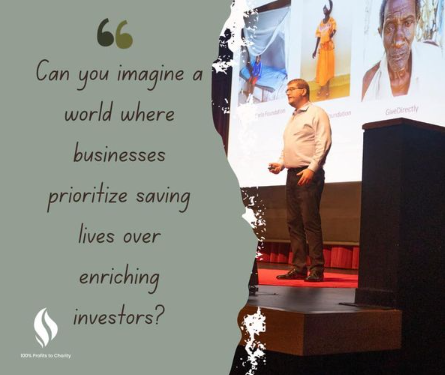For years, I’ve been putting almond butter on my toast every morning. Tasty, filling, and nutritious, it felt like a good way to start my day. But the price of almonds where I live has nearly doubled in recent years, due to a combination of higher demand and smaller yields from drought-striken California. A few months ago, I gasped when I saw the price of a 1-pound jar of almond butter at my local market: it was more than $15. I was going through a pound of almond butter roughly every 10 days, which meant it was costing me $45 per month. In contrast, a pound of peanut butter would cost me $5. I decided to switch, saving $30 per month. The change wasn’t hard: I like peanut butter.
Saving $30 per month translates to $360 annually, and when I saw that figure I realized that I had just discovered an easy, no-sacrifice way to increase my giving to effective charities (beyond what I already give). It turns out there are lots of opportunities like this, which can be broken into three categories: 1) Eliminating things you pay for but don’t actually use, 2) Replacing things you buy frequently with cheaper but just-as-good alternatives, and 3) Giving “found money,” which can include things like credit card cash-back rewards or even money found on the sidewalk. The final step is to tally up your savings and ensure that they go to your chosen charity(ies) instead of getting absorbed back into your monthly spending.
The traditional giving season is upon us, as is the time of year when many people set goals and resolutions for the new year. What better opportunity to look for ways to boost our giving by spending money more efficiently and consciously?
Eliminate things you pay for but don’t use
Periodically evaluating your subscriptions to publications, memberships, and services can reveal opportunities to free up money that you can then use to increase your giving. I used to subscribe to six magazines. Three of them arrived every week, two came once a month, and one was published each quarter. There was no way I could keep up with the weeklies: they piled up and became a source of clutter, guilt, and stress, and even the monthly magazines often sat unread on the shelf. Eventually I realized that I was paying a lot for things that brought me little value. I cancelled all the subscriptions except for the quarterly magazine, saving more than $350/year. Now if I want to read magazines, I go to the library or look online.
Mobile phone plans are another area where we often pay more than we need to. I live in Canada, which vies with Australia as the world’s most expensive place to operate a mobile phone. When I first got a smartphone, I bought an unlimited data plan since I didn’t want to worry about going over my limit if I downloaded some music or watched a video. That plan cost me $95 per month, including taxes and fees. But after living with the phone for a while, I looked up my usage and found that I wasn’t using much data at all. I cut back to a data-limited plan at less than half the monthly fee I was paying before. Ultimately I decided that I didn’t need a data plan at all: I work at home, don’t travel much, and can usually find free WiFi if need to check email or browse the web when I’m out and about. I switched to a voice-only plan for a few years, and then decided to go with a cheap prepaid plan. My mobile phone service now costs me $100 per year, including all my calls and texts. That’s a savings of $1,040 annually, which goes straight to the effective charities I support.
You may not be willing or able to make such a drastic change, but if your monthly data use is typically far below your plan’s limit, you should be able to save by downgrading.
Replace things with cheaper but just-as-good alternatives
Items you purchase regularly may offer opportunities to reduce costs, not by giving them up but by switching to a cheaper brand or alternative. My switch from almond butter to peanut butter is an example. If you buy particular brands of food, medicine, or other items out of habit or loyalty, try experimenting with cheaper brands to see if you’d be happy enough with them.
Daily habits are a good place to start looking for such opportunities. If you buy a newspaper every day, could you replace it with free or cheaper online news sources? If you treat yourself to a daily latte (perhaps the most over-used example of an opportunity to curb daily spending), could you be just as satisfied drinking a cup of regular coffee with milk?
The point here is not to give up habits, foods, and products you like, but to see if you can replace them with alternatives that you like just as much—but that cost less. Then tally up your monthly savings and set them aside for charity.
Give “found money”
My girlfriend has an amazing ability to spot coins and bills dropped on the sidewalk and street. Maybe it’s because she’s a foot shorter than I am, and thus her eyes are closer to the ground, but I almost never find money that way. She, on the other hand, regularly finds $40 to $80 per year, which she places in a jar on her desk and then uses to top up her end-of-the-year giving in December. It’s not much, but when you consider that $80 given to the Against Malaria Foundation could fund 19 bednets that will protect 35 people from a debilitating illness, it’s hardly insignificant.
Other sources of found money include cash rewards (such as those from cash-back credit cards) and the savings from food points at grocery stores.
From saving to giving
Many of the suggestions above are commonly recommended ways to help people save money for themselves. And they work for that purpose. But if you want to use them as a strategy to increase your giving over and above what you already give, you need to ensure the savings actually end up going to charities rather than being used for some other purpose or getting lost in your everyday spending. Here are a few ways to make that happen:
- Set up a separate bank account for your charitable giving, and transfer your monthly savings into it. Some banks allow you to set up accounts for no fee, so this is an easy way to segregate the funds you want to use for giving.
- If you give monthly, increase your monthly giving by the amount you’ve saved each month by changing your habits.
- If you use a budget, simply increase the amount in your monthly budget category for giving to ensure that your savings are captured.
Take some time this holiday season to find ways to increase your giving above and beyond your normal amount. Even small changes can add up!



